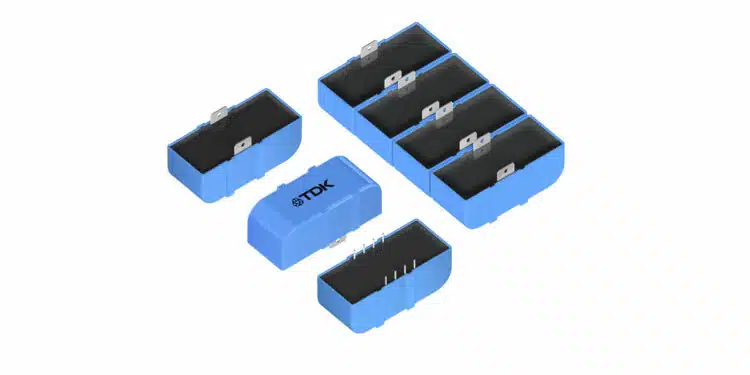TDK Corporation introduces the xEVCap, a standardized and modular DC link capacitor design for powertrain inverters in passenger cars, commercial and off-highway vehicles, and machinery tools.
Typically, such capacitor designs are fully customized, making the development time-consuming and practical only in large production volumes. In addition, if the customer requirements change during the project, this can further increase the time required for capacitor development and thus delay the overall project.
However, with the scalable and modular xEVCap, TDK helps inverter designers meet varying capacitance and current requirements at lower volumes while saving valuable time. This approach also reduces costs by utilizing standardized capacitor modules, which minimizes the variety of components that need to be stocked. To meet different capacitance and ripple current requirements, multiple xEVCaps can be easily connected in parallel. The complete capacitance range complies with the automotive standards AEC-Q200 rev. E and IEC TS 63337:2024.
The xEVCap is available in two connection styles: the B25654A*001 has lead wires for soldering to busbars or PCBs, while the B25654A*002 has flat terminals for welding or screwing to busbars. Each variant is available in multiple different mechanical versions and voltage levels.
The mechanical versions are 85 x 47 x 40.5 mm (L x W x H), 97.5 x 35.5 x 42.5 mm, and 109 x 47 x 40.5 mm. Corresponding with rated voltages, components for 500 V, 650 V, 850 V, and 920 V are available. Depending on the rated voltages, the capacitances range from 60 µF up to 270 µF. All xEVCaps are included in TDK’s CLARA (Capacitor Life And Rating Application) tool, which simulates the components electrically and thermally under different operating conditions. STEP files and SPICE models for the components are available for download.
For a limited time, the applied voltage can exceed the rated voltage. For example, the 850-V types can withstand 890 V for 100 hours at +105 °C and surge voltages of up to 1200 V. Rated currents range from 35 A to 60 A (at 10 kHz) with ESL values of 14 nH or 17 nH (at 1 MHz). The operating temperature range is -40 °C to +105 °C.
Features
- Scalable and modular for different power levels and densities
- Compatible with wide-bandgap power semiconductors (SiC, GaN)
- Good self-healing properties
- Low ESR and low ESL
- Compliant to IEC TS 63337:2024 (all versions)
- Compliant to AEC-Q200 rev. E (lead wire versions)
Applications
- DC link for main traction inverters in passenger cars, commercial and off-highway vehicles, machinery tools































